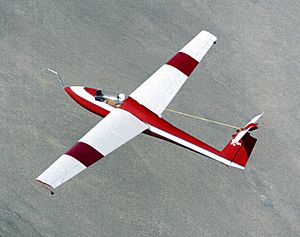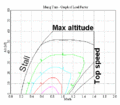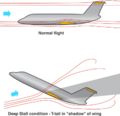Stall (flight) facts for kids
A stall happens when an airplane's wing cannot make enough lift. Lift is the upward force that keeps an aircraft in the air. When a plane stalls, it means the wings are no longer creating enough lift to keep the aircraft flying level. Stalling can be risky, especially when flying close to the ground.
Contents
What is an Aircraft Stall?
An aircraft stall is not when the engine stops working. Instead, it's about the airflow over the wings. For a wing to create lift, air must flow smoothly over its curved top surface. If this airflow breaks away, the wing stops producing enough lift, and the plane starts to fall.
Why Do Planes Stall?
A stall often happens because the plane is flying too slowly. To keep the plane up at a slower speed, a pilot might point the nose of the aircraft up. This increases the "angle of attack." The angle of attack is the angle between the wing and the oncoming air.
Increasing the angle of attack usually helps create more lift. However, there's a limit. If the angle of attack becomes too steep (often around 16 degrees), the smooth airflow over the wing breaks apart. When this happens, the lift suddenly drops, and the aircraft stalls. This special angle is called the critical angle of attack. An aircraft will always stall if it goes beyond this critical angle, no matter how fast or slow it is flying.
How Pilots Know a Stall is Happening
Pilots are trained to recognize the signs of a stall before it fully happens. This helps them prevent it or recover quickly.
Signs that a stall might be starting include:
- The plane is flying very slowly.
- The nose of the plane is pointed high up.
- The controls (like the stick or yoke and rudder pedals) feel less responsive.
- A slight shaking or "buffet" can be felt in the controls.
If the stall fully develops, the signs are more obvious:
- Strong shaking in the controls.
- The nose of the plane drops suddenly.
- The aircraft starts to fall downwards.
If the pilot doesn't use the controls smoothly during a stall, the plane could even start to spin. A spin is a dangerous, uncontrolled spiral descent.
How Pilots Recover from a Stall
Pilots learn specific steps to recover from a stall safely:
- First, the pilot must push the nose of the plane down. This helps the wings get back to a safe angle of attack and allows air to flow smoothly over them again.
- Next, the pilot increases the engine power using the throttle. This helps the plane gain speed.
- Once the plane gains enough speed and the wings start producing lift again, the pilot can level the wings.
- Finally, the pilot gently pulls up to return the aircraft to its planned flight level.
What is a Deep Stall?
Some aircraft designs, especially those with a "T-tail," are at risk of a special type of stall called a deep stall. A T-tail means the horizontal part of the tail (where the elevators are) is placed high up on top of the vertical fin, looking like the letter "T".
In a deep stall, the turbulent (choppy) air coming off the stalled wings can block the airflow over the elevators on the tail. The elevators are small flaps that help the pilot push the nose up or down. If the elevators are blocked by turbulent air, it becomes very hard for the pilot to push the nose down and recover from the stall. This makes a deep stall much harder to escape than a regular stall.
Images for kids
-
Airflow separating from a wing at a high angle of attack, which happens during a stall.
See also
 In Spanish: Entrada en pérdida para niños
In Spanish: Entrada en pérdida para niños






